A rise in the snow leopard population in Himachal Pradesh was anticipated. Locals in Spiti Valley have told me that the region’s snow leopard prey population has grown steadily in recent years.
I expected the snow leopard population to grow, because the density of prey (primarily mountain ungulates like blue sheep and ibex) is closely tied to the snow leopard population.
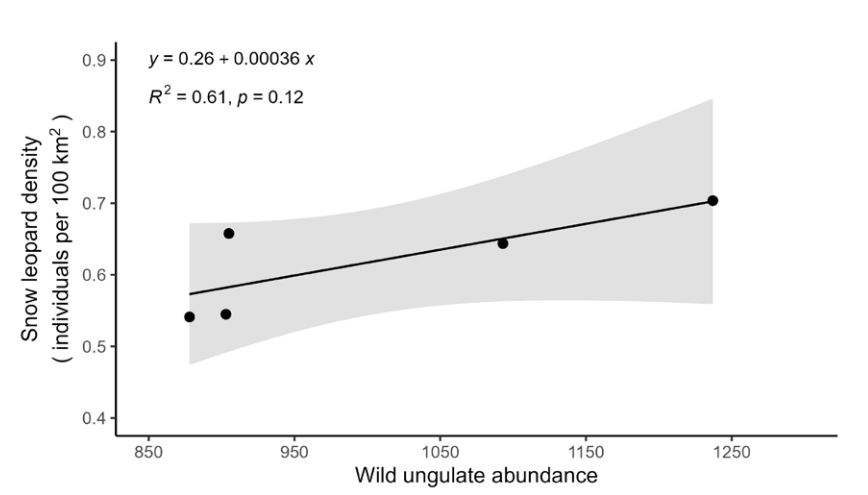
On October 13, 2025, the Nature Conservation Foundation (NCF) released the second edition of the Snow Leopard Population Assessment of India (SPAI), which revealed a remarkable (62.7%) increase in the state’s snow leopard population compared to the first assessment survey.
Assessing the population of snow leopards is a tough task. Since this montane mammal inhabits remote, isolated, difficult to access and cold high-altitude regions of unforgiving terrain, setting up camera traps, monitoring and maintaining the cameras, swapping memory cards and accurately identifying individual snow leopards requires exceptional skill, patience and endurance.
NCF + Wildlife wing of the Himachal Pradesh Forest Department and a team of locals surveyed almost half of the state’s geographical area (26,000 square kilometers) to assess the distribution and density of snow leopard population in the state.
What struck me most was the crucial role locals played in the survey and the part they play in conservation of the indigenous wildlife. It was highlighted by the Himachal Pradesh Forest Department in a foreword written by the Principal Conservator of Forests, Wildlife.
Along with snow leopards, the camera traps setup by NCF and Wildlife Wing of the Forest Department of the state incidentally captured other mammal species, such as:
- Pallas’s cat Otocolobus manul from Chango village (near Nako), Kinnaur.
- Woolly flying squirrel (Eupetaurus cinereus) from Miyar valley in Lahaul.
- Blue sheep (Pseudois nayaur) from Hangrang valley of Kinnaur and along Spiti and Lingti river basin of Spiti valley.
- Himalayan brown bear (Ursus arctos) from Pangi and Bharmour region of Chamba, Lippa Asrang Widlife Santuary and Rackchham-Chitkul Widlife Sanctuary of Kinnaur, and regions of Lahaul adjacent to Chamba.
- Himalayan wolf (Canis lupus) from regions around Tabo and along Spiti river drainage basin.
- Himalayan ibex (Capra sibirica) from area beyond Mud village and between Mud and Sagnam village of Pin valley, region falling between Kibber and Losar village of Spiti valley, Chandra-Bhaga drainage basin and Miyar valley of Lahaul & Udaipur subdivision.
- Common leopard (Panthera pardus).
- Mountain weasel (Mustela altaica).
- Himalayan musk deer (Moschus leucogaster).
- Red fox (Vulpes vulpes).
- Stone marten (Martes foina).
- Yellow-throated marten (Martes flavigula).
Population assessment of snow leopards in Himachal Pradesh
The Nature Conservation Foundation (NCF) and Wildlife Wing of Himachal Pradesh Forest Department started conducting its first population estimate of snow leopards in Himachal Pradesh under Population Assessment of the World’s Snow Leopards (PAWS) project in 2017.
Himachal Pradesh was the first state to estimate the snow leopard population, which it completed in 2021.
PAWS is an intergovernmental project of 12 snow leopard range countries, which is conducted under the Global Snow Leopard and Ecosystem Protection Program (GSLEP). The Indian government has formulated country specific guidelines and protocols for scientific estimation of snow leopard population, and referred to it as Snow Leopard Population Assessment of India, or SPAI.
The second round of population estimates started in late 2023, and it constituted through 2024. It took the NCF and Forest Department of the state about a year to complete the fieldwork.
I spoke with Munib Khanyari, a researcher and program manager at NCF, about how NCF made it possible in less than one year. Munib also contributed to the second round of the population estimate under SPAI in Himachal Pradesh.
“This time, we had a lot more involvement from local communities, which led to quicker surveys being done. Also, many of our core team members are more experienced now, so it made surveying the area again much easier.”
Munib Khanyari
Snow leopards live in 26,112 square kilometers of rugged landscapes in Himachal Pradesh. The high altitude region they inhabit has deep gorges surrounded by steep cliffs with thin air and scare vegetation. Covering over 26K square kilometers (roughly half the state’s geographical area) in less than a year is a monumental exercise.
NCF employed stratified sampling design technique to survey the vast region. Under this technique, the large snow leopard habitat area of the state was divided into smaller blocks/strata of:
- High strata region: areas of high snow leopard population/occupancy density, i.e. high altitude regions of Spiti valley, Pin valley and Kinnaur.
- Low strata region: regions of low snow leopard population/occupancy density, i.e. Great Himalayan National Park (GHNP) Kullu, Lahaul and Pangi region of Chamba.
Findings of SPAI 2.0 in Himachal Pradesh
- The second round of SPAI in Himachal Pradesh estimated 83 snow leopards, with Confidence Interval (CI) of 95% confidence level in 67 to 103 range. 44 individual snow leopards were sighted. In the low strata region, the estimated population was 24 snow leopards (with CI of 95% confidence level in 19 to 30 range) and in the high strata region, the estimated population range is 59 snow leopards (with CI of 95% confidence level in 48 to 73 range).
- Snow leopard density in Himachal Pradesh is 0.35 (with CI of 95% confidence level in 0.23 to 0.53 range) individuals per 100 square kilometers.
- 90 times snow leopards were detected in camera traps in high altitude regions (between Losar village and Kibber and core area of Kibber Wildlife Sanctuary) of Spiti valley, and 12 individual snow leopards were sighted.
- 46 times snow leopards were detected in camera traps in regions around Tabo (between Schilling and Hurling villages, cliffs near Tabo village and between Gue and Sumdo checkpost) of Spiti valley, and 6 individual snow leopards were sighted.
- 35 times snow leopards were detected in camera traps in Pin Valley (Along Ensa Nallah, regions beyond Mud village and near Sagnam village), and 8 individual snow leopards were sighted.
- 58 times snow leopards were detected in camera traps in Kinnaur (area falling in Lippa-Asrang Widlife Santuary, regions beyond Ropa village, and area falling between Hango village and Ropa of Ropa Valley, and between Khab bridge and Shalkhar-Thang Karma of Hangrang valley). 9 individual snow leopards were sighted in Kinnaur.
- 32 times snow leopards were detected in camera traps in Lahaul and Pangi Tehsil of Chamba (in Miyar valley, drainage basin of Chandra and Bhaga, regions surrounding Keylong), and 8 individual snow leopards were sighted.
- In GHNP, camera traps had only one detection, and only one individual snow leopard was seen.
- Snow leopard population increased linearly with an increase in its prey population (mainly blue sheep and Himalayan ibex).
- Snow leopard population density in the high occupancy strata region was 0.46 (0.37 – 0.57 CI range) snow leopards per 100 square kilometers.
- Snow leopard population density in the low occupancy strata region was 0.18 (0.14 – 0.23 CI range) snow leopards per 100 square kilometers.
- The high altitude regions of Spiti valley have the highest snow leopard population density of 0.53 (CI of 95 percent and 0.30 to 0.94 range) snow leopards per 100 square kilometers.
- The Pin valley has the second-highest snow leopard population density of 0.51 (CI of 95 percent and 0.26 to 1.01 range) snow leopards per 100 square kilometers.
- Kinnaur district has the third-highest snow leopard population density of 0.44 (CI of 95 percent and 0.23 to 0.84 range) snow leopards per 100 square kilometers.
- The Tabo region of Spiti valley has the fourth-highest snow leopard population density of 0.35 (CI of 95 percent and 0.16 to 0.77 range) snow leopards per 100 square kilometers.
It is interesting to note that the camera traps installed across the snow leopard range in Himachal Pradesh detected the same number (44) of individual snow leopards as in the first round of SPAI (from 2017 to 2021). In this survey, 51 snow leopards were estimated in Himachal Pradesh (with a confidence level of 95% in the range of 44 to 73).
| Name of Protected Area | Number of camera traps deployed | Number of snow leopard detected on camera traps | Number of individual snow leopards identified |
| Pin Valley National Park | 11 | 11 | 4 |
| Kibber Wildlife Sanctuary | 13 | 40 | 6 |
| Sechu Tuan Nala WildlifeSanctuary | 6 | 3 | 1 |
| Great Himalayan National Park | 16 | 1 | 1 |
| Sainj Wildlife Sanctuary | 2 | 0 | 0 |
Confidence Interval (or CI) is a statistical parameter calculated from sample data. It determines the range of values within which an entity can fall with a degree of confidence in a percentage. For example, the SPAI 2.0 estimated the population of snow leopards to be 83, with a CI of 95% confidence level in 67 to 103 individuals.
A CI provides crucial information about confidence level. It is the reliability of the method used to generate the interval. SPAI 2.0 has a confidence level of 95%, and if the assessment were repeated 100 times, 95 out of 100 confidence intervals would be expected to contain the true number of snow leopards.
A narrower interval (44 to 73 in the first round of SPAI) corresponds to a smaller margin of error, and it provides a more precise estimate with certainty than a wider interval (67 to 103 in SPAI 2.0).
Prey population
Mountain ungulates (blue sheep and Himalayan ibex) make up most of the snow leopard diet. It is obvious that regions with high mountain ungulate density can lead to the growth of the snow leopard population.
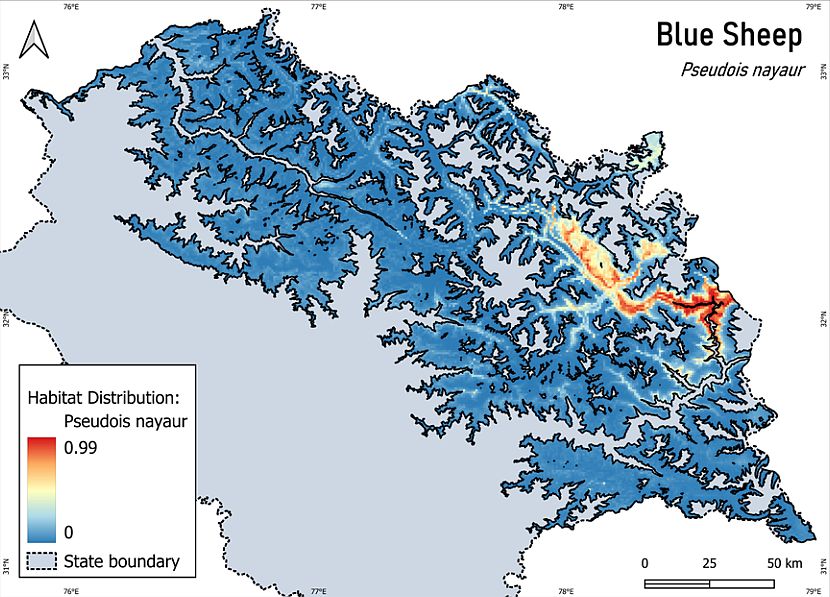
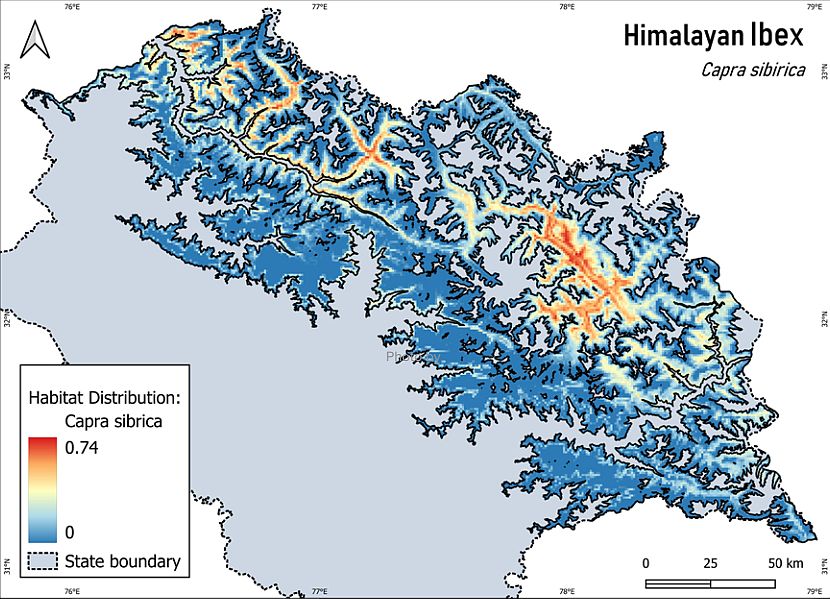
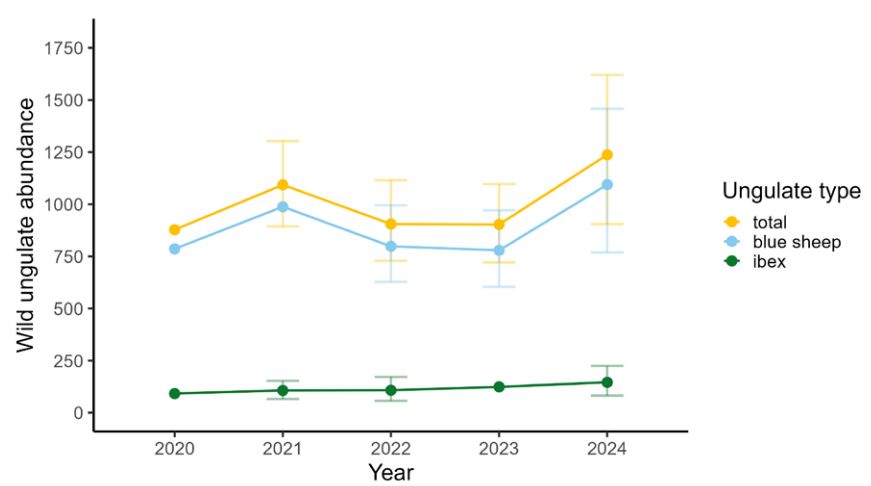
The number of blue sheep has shown rise and fall over the years. Overall, their count has risen from 786 in 2020 to 1094 in 2024 in its habitat in Himachal Pradesh. However, the population of the Himalayan ibex has grown steadily, from 92 in 2020 to 146 in 2024.
Camera traps setup and local community support
271 Reconyx Hyperfire 2 and Reconyx HC500 infrared motion detection cameras were installed to capture sightings of snow leopards. At least one camera trap was deployed in a 4 x 4 km grid area of snow leopard range.

The captured images were tagged using the digiKam, an open source image management software used for geotagging, importing images/videos from cameras and assigning tags to images.
The image recognition and tagging process was conducted in two steps. In the first step, two researchers independently identified a photo imported from a camera with the rosette patterns. In the second step, IDs and tags were reviewed by an independent researcher.
“Just as we humans have unique thumbprints, each snow leopard individual has unique rosette patterns. We used a robust two-step process, first two independent observers check for individual identification, and then any mismatch between them is resolved by a third observer.”
Munib Khanyari
The NCF held workshops with the Wildlife Wing of the Forest Department to train its workforce in the installation of camera traps, SPAI guidelines and data collection protocols, assessment workflows, image identification and tagging.
| Name of Site | Estimated Area (in square kilometers) | Monitoring Period | Number of camera traps deployed | Number of Occasions |
| Kinnaur | 1229 | March to May 2024 | 56 | 60 |
| Tabo | 862 | June to early September 2024 | 51 | 60 |
| Pin valley | 754 | June to early September 2024 | 39 | 60 |
| High altitude regions of Spiti | 1191 | June to early September 2024 | 45 | 60 |
| Lahaul & Pangi | 5096 | October to early December 2024 | 62 | 60 |
| GHNP | 256 | September to November 2023 | 18 | 45 |
20 employees of the Himachal Pradesh Forest Department working in the Spiti Wildlife Division, and 11 women from Kibber village were trained.
The women of Kibber showed incredible courage and skills in setting camera traps, processing and tagging camera trap images.
Most women had never seen a snow leopard in the wild, but they show remarkable talent in recognizing snow leopards from rosette patterns and tagging the image in the digiKam, even though they had never worked on computers in their lives before.
The fieldwork was made possible by the support and participation of local communities, esp in installation of camera traps, data collection and identification of snow leopards.
| Monitoring site | Estimated area of surveyed region (in square kilometers) | Number of Camera Traps Deployed | Number of Nights Cameras Remained Active | Number of times snow leopards were captured on camera | Number of individual snow leopards identified | Estimated Snow Leopard Density per 100 km² (95% CI): |
| Kinnaur | 1229 | 56 | 3080 | 58 | 9 | 0.44 (0.23 to 0.84) |
| Tabo | 862 | 51 | 2745 | 46 | 6 | 0.35 (0.16 to 0.77) |
| Pin valley | 754 | 39 | 2156 | 35 | 8 | 0.51 (0.26 to 1.01) |
| High altitude regions of Spiti | 1191 | 45 | 2538 | 90 | 12 | 0.53 (0.30 to 0.94) |
| Lahaul-Pangi | 5096 | 62 | 2753 | 32 | 8 | 0.18 (0.09 to 0.36) |
| GHNP | 256 | 18 | 734 | 1 | 1 | 0.16 (0.03 to 0.80) |
Since locals have a wealth of knowledge of the flora and fauna and unique features of the landscape inhabited by snow leopards, it was essential to work with local communities on the ground.
In total, 23 people from Hango village of Kinnaur, Kibber village of Spiti and Hudan village of Pangi Tehsil of Chamba worked with NCF and Himachal Pradesh Forest Department.
Incidental sightings of other mammals
Snow leopard was the target species of snow leopard population assessment under SPAI, but the camera traps also captured other mammals across the snow leopard range of Himachal Pradesh.
The following mammals were sighted for the first time in the state:
- Pallas’s cat (Otocolobus manul) sighted near Hango village of Kinnaur
- Woolly flying squirrel (Eupetaurus cinereus) sighted in Miyar valley of Lahaul.
Threats to snow leopards
In the Status of Snow Leopard in Himachal Pradesh 2025 research report, NCF and Himachal Pradesh Forest Department recognized following threats to snow leopards:
- Large-scale mining and green energy projects (solar and hydro) are reducing snow leopard habitat.
- Livestock predation by snow leopards leads to retaliatory killings by pastoral communities.
- Unregulated tourism and poor waste management in snow leopard regions of Himachal Pradesh are causing a rise in feral dog population. The feral dogs were found across the state’s snow leopard range, killing and chasing snow leopards and their prey.
Munib was also concerned about the conflict that feral dogs were causing in Himachal Pradesh’s snow leopard habitats, particularly in the Lahaul and Spiti regions.
“This is one of the biggest problems snow leopards face in India and the globe! Feral dogs can kill snow leopards, eat their prey, and also transmit disease. We need to urgently deal with this issue.”
Munib Khanyari
On the proposed 880MW solar energy project in Spiti, Munib said:
“These large solar farms will definitely be super damaging for the local wildlife and lifestyles in these regions. They will destroy habitat and fragment populations. They can also have negative health impacts on wildlife through increased stress levels and lower quality of food.”
Munib Khanyari.
As snow leopards are considered an umbrella species of the landscapes they inhabit, rise in its population is a good indicator of healthy population growth of the other wildlife in snow leopard ranges of Himachal Pradesh.
Although the population increase is encouraging, large-scale green energy projects, waste generated by unregulated tourism, and increasing intrusion by free-ranging dogs in the snow leopard habitat of Himachal Pradesh continue to pose significant challenges.
- Insights from SPAI Snow Leopard Population Study in Himachal Pradesh – October 21, 2025
- Himachal Pradesh Home Stay Rules 2025 – June 26, 2025
- HRTC Baggage Policy & Terms Decoded (Tips & Fee Chart) – April 21, 2024

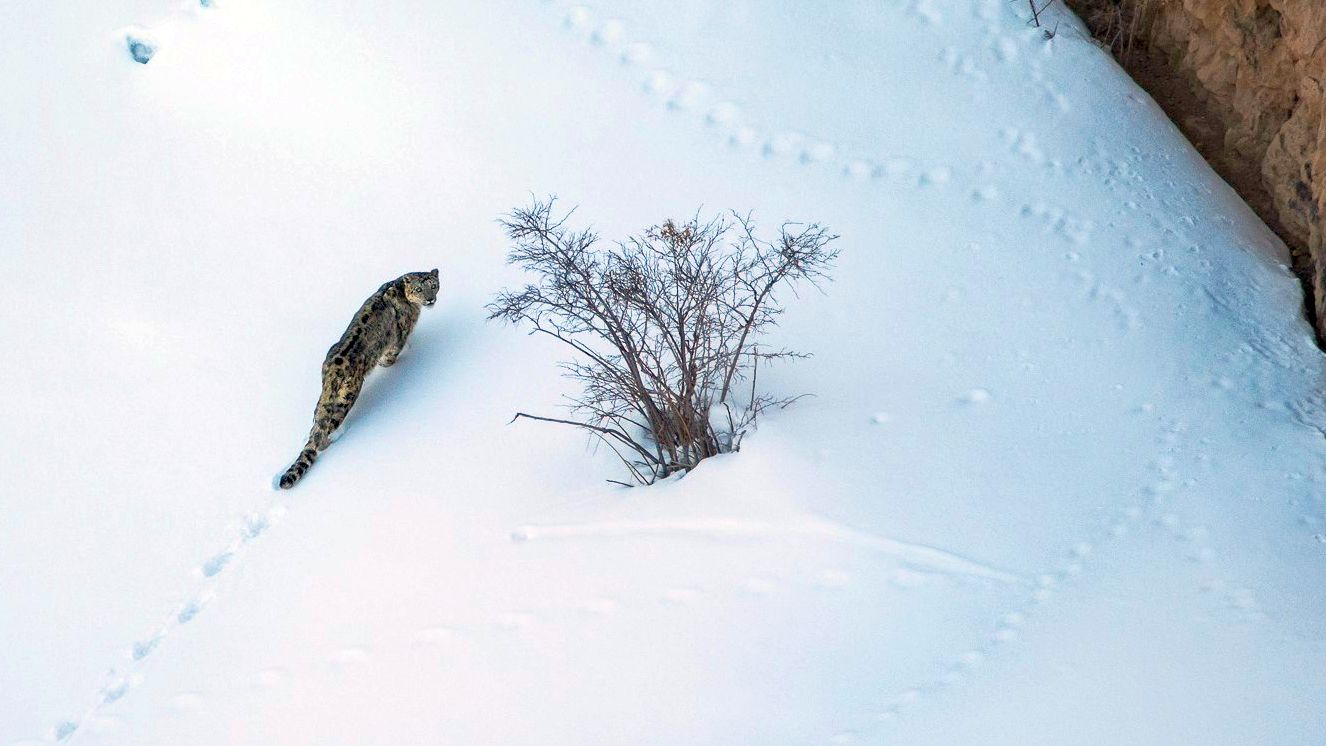
Leave a Reply